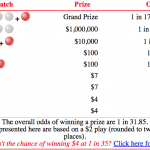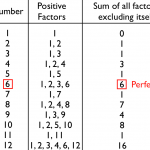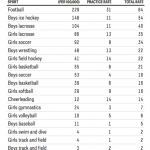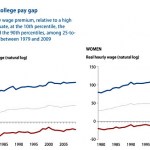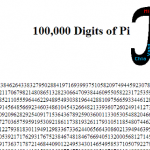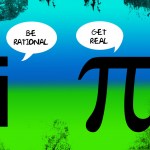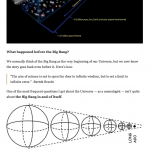math
I was thinking about something only tangentially related to grading, when it struck me that the way we go about generating student grade point averages is the kind of mind-bogglingly stupid system that requires lots of smart people working together to produce. Two very different groups of smart people, with very different ways of looking at the world.
As a scientist, the starting point for assigning grades is generally a set of scores on a bunch of individual assessments. These are generally combined to form some sort of weighted average, which can be expressed as something like a percentage…
SteelyKid's school does a "March Math Madness" thing, and this year all the kids in her class are being asked to practice "Math Facts" for ten minutes a night. This appears to be motivated by some requirement that students be able to rattle off basic addition problems at high speed. So there are flash cards and the like.
She's good at this, but quickly gets bored, and does not hesitate for an instant in letting her boredom be known. It'll be sort of interesting to see how this plays out if they actually expect her to answer 30 addition questions in a minute, or whatever the ridiculous…
No one science can stand wholly on its own. For inquiry about the Universe to give a correct, complete picture, it requires that we bring in a whole slew of evidence, often from tangentially related fields.
Image credit: Professor Kenneth R. Lang, Tufts University.
The interplay between three fields in particular -- astronomy, physics, and math (not a science, but the tool used to help understand the relationships arising in the first two) -- have given rise to the most successful picture of the Universe of all-time.
But how did this come to be?
Image credit: Scott Dodelson.
Brian…
“I’ve done the calculation and your chances of winning the lottery are identical whether you play or not.” -Fran Lebowitz
It's a thought that's occurred to almost everyone at some point or another: what each of us would do if we happened to hit the lottery Jackpot. Have a listen to Camper Van Beethoven sing about it in the band's interesting song,
When I Win The Lottery,
while you consider the following.
Image credit: me. The (very small) differences in these odds and the Powerball official odds are due to rounding.
This past week, the Powerball Jackpot crested past $500 million…
(When I launched the Advent Calendar of Science Stories series back in December, I had a few things in mind, but wasn’t sure I’d get through 24 days. In the end, I had more than enough material, and in fact didn’t end up using a few of my original ideas. So I’ll do a few additional posts, on an occasional basis, to use up a bit more of the leftover bits from Eureka: Discovering Your Inner Scientist…)
While Eureka is built around stories, it's really a book about the process of science, using those stories to highlight particular aspects of the scientific process. The hope is that making the…
I've seen a lot of reshares of this report about the long-term effect of gender bias in elementary math, which comes from an NBER working paper about a study of Israeli schools. The usual presentation highlights one specific result, namely that on a math test graded by teachers who knew the names of the students, boys outscored girls, but a blinded test saw girls outscore boys.
This sounds pretty damning, but also kind of puzzling-- is there really that much room for partial credit in elementary school math? Looking at the actual paper (which you can get emailed to you if you have a .edu…
Math with Bad Drawings has a post about "word problems" that will sound very familiar to anyone who's taught introductory physics. As he notes, the problem with "word problems" for math-phobic students is that it requires translating words into symbols, and then using the symbols to select a procedure. It adds a step to what at a lower level is a simple turn-the-crank algorithm: given this set of symbols, do these abstract operations, and write down the answers.
This is a very familiar problem in intro physics, where I regularly have struggling students tell me "I can do the math just fine, I…
“Our external environment no longer seems to have any firm boundaries, any limits, or any positive cues about when to stop consuming anything. I mean, there is a reason that people get fat — it’s easy and cheap to get high-calorie, tasty food.” -Bob Harper
There are plenty of good things we can all do to get healthier, and then there are plenty of things we should never do to our bodies. Yet somehow, there's a show I know is doing it all the wrong way, and yet I can't look away.
Image credit: © NBC Universal / Trae Patton, Biggest Loser season 14 episode 11.
Yes, folks, I'm a fan…
“If everything was perfect, you would never learn and you would never grow.” -Beyoncé
As human beings, we may be far from perfect. Even our mathematical celebrations, like Pi Day, are mere approximations. But there are a few mathematical quantities out there that really are perfect. And today, June 28th, I'd like to share with you a celebration we should all be able to partake in: perfect number day!
Image generated by me.
Most numbers are deficient, in the sense that if you added up all their divisors (other than themselves), you get a number less than the original one you…
Rhett and I did the 15th episode of our Uncertain Dots hangout yesterday, commenting on a discussion started by Casey Rutherford about what we would like students coming into college physics to know. We had a slight difference of opinion about physics content, but agreed about the importance of algebra (which is like sunscreen).
I had meant to post this last night, but SteelyKid has made friends with the kids at one of the houses behind ours, so I spent a good chunk of the evening making sure she didn't climb over the fence into their yard. So, instead, you get to wake up with our physics…
Over at Five Thirty Eight, Walt Hickey has a piece about cheerleading as a sport and injury rates, which is both a nice look at the way to use stats to measure the real danger level of an activity, and the sort of small details that can be teased out. The piece includes a table of injury rates for a wide variety of sports, seen above as the "featured image" and reproduced below. I don't really have anything much to say about cheerleading, but one thing did jump out at me from the table, leading to the question in the post title.
this table show concussion rates in competition and in practice…
While I'm complaining about statisticulation in social media, I was puzzled by the graph in Kevin Drum's recent post about college wage gaps, which is reproduced as the "featured image" above, and also copied below for those reading via RSS. I don't dispute the general phenomenon this is describing-- that the top 10% of college grads earn way more than the average, and the bottom 10% way less, and somewhat less than high school grads-- but I'm baffled about what was done to generate this graph.
Specifically, I'm puzzled by the vertical axis, which is labeled "Real hourly wage (natural log)."…
Via a mailing list, probably via this Tyler Cowen post, an awful statistic about adjunct faculty:
35 years ago there were 44% more tenured faculty than adjuncts. Today there are 76% more adjuncts than tenured faculty, via @chronicle
— Ángel Cabrera (@CabreraAngel) April 25, 2014
This is awful in two ways. First, it's obviously a sad comment on the state of the college teaching profession. More importantly, though, it's a classic abuse of statistics, using a really confusing presentation of the numbers to exaggerate an effect that doesn't really need it.
Here, let's try this as a poll, since…
The 3rd USA Science & Engineering Festival, the nation's largest celebration of STEM, is just one month away! This FREE and open to the public event will take place April 26 & 27 at the Washington, D.C. Convention Center. Over 250,000 attendees will experience the weekend of a lifetime with 3,000 hands on exhibits, 150 stage shows, including presentations from science celebrities Bill Nye and Michio Kaku, teacher development workshops, a Festival Book Fair and much much more!
Here is just a sampling of the upcoming stage shows at the Festival Expo Finale:
Learn From Mike Rowe of…
Today is March 14th, 3/14 in the normal American way of writing dates, so you'll find a lot of silliness on the web today talking about "π Day" due to the coincidental similarity with the first three digits of π (see, for example, Rhett's annual post). But, of course, this is an archaic and local convention, and not really suited to the dignity of science.
After all, the defined SI unit of time is the second, so if you're going to do things properly, you really ought to measure time in seconds (like the Qeng Ho in Vernor Vinge's brilliant A Deepness in the Sky). So, a proper celebration of…
“So here we have π squared, which an engineer would call ‘10.’” -Frank King
This March 14th, stump your friends with these amazing facts about the world’s favorite transcendental number!
Image credit: Wikimedia Commons users TechnoGuyRob and InverseHypercube.
I've written about Pi Day twice before here on Scienceblogs, but for this year's festivities, I've assembled a collection of my favorite facts about everyone's favorite irrational but indispensible number, from history to pure mathematics to birthdays to astronomy!
Image credit: Emil Ivanov, via http://www.emilivanov.com/CCD%20Images…
“There is not enough love and goodness in the world to permit giving any of it away to imaginary beings.” -Friedrich Nietzsche
You know that the square root of -1 is “i”, an imaginary number. But did you know any of these?
For classical (Newtonian) mechanics, as well as electromagnetism, it's sufficient to use real mathematics to describe it fully, if not always ideal. But to take care of Einstein's relativity (and spacetime in particular), as well as quantum mechanics, you need to go beyond the real numbers and into the complex plane, which includes imaginary numbers as well!…
The price of human genome sequencing has fallen spectacularly since the turn of the century; what then cost $100,000,000 is now promised for only $1000. This race toward zero makes even Moore's Law look like a snail's pace, but the $1000 price tag does come with a couple asterisks. For one, providers will need high demand to pay off the multi-million dollar sequencing array that makes it possible, and low demand should result in higher prices. For two, $1000 will only buy you a rough draft of your genome. On Discovering Biology in a Digital World, Todd Smith writes "While some…
"There are three hundred and sixty-four days when you might get un-birthday presents, and only one for birthday presents, you know." -Lewis Carroll
It's the end of the week once again, and so it's time for yet another Ask Ethan column! This week, I was asked a wonderful math question by Keith H., who wanted to know:
Among my 1,434 [Facebook] friends, it's nobody's birthday today. Given the 365.25 days in a year, what are the odds of a day like this? Show your work.
Assuming that none of your friends were born prior to March 1, 1900, this is the right starting point.
Image…
The local sports-talk radio station is running a bunch of commercials from a tax prep service in which a loud announcer declares that "People who did their own taxes left one billion dollars on the table last year. That's billion with a 'b.'" and urges people to "Get your billion back!" by paying for their tax-return service. Which, you know, sounds like quite a bit.
Only, there are upwards of 300 million people in the US. So, a billion dollars is about $3 per person. So, it's maybe not as impressive as they want you to think.
Of course, a lot of those people are too young or too old to be…


